
Resource Links, published 5 times a year is Canada’s national journal devoted to the review and evaluation of Canadian resources for children and young adults.
Resource Links reviews new information books, picture books and novels for children and young adults, audio-visual materials, computer software, and Internet resources for young people and professional literature of interest to teachers and librarians.
Resource Links informs you about Canadian writers, awards and announcements. Everything of interest to a Canadian audience.
Resource Links is written by educators, librarians and writers working with young people across the nation. Our reviewers span the country from British Columbia to Newfoundland.
For subscription information, feature columns, excerpts, and a comprehensive index visit the Resource Links website at www.resourcelinksmagazine.ca.
There are always some titles which stand out in each issue of Resource Links, titles to which our reviewers give the Excellent Rating. Each year in our December issue we list “The Year’s Best” and also place it on our website. In this listing I have included some of these titles which I feel are the ‘best of the best’ according to our reviewers. If you are interested in the total list check out the December 2019 issue or check our website at www.resourcelinksmagazine.ca
Picture Books
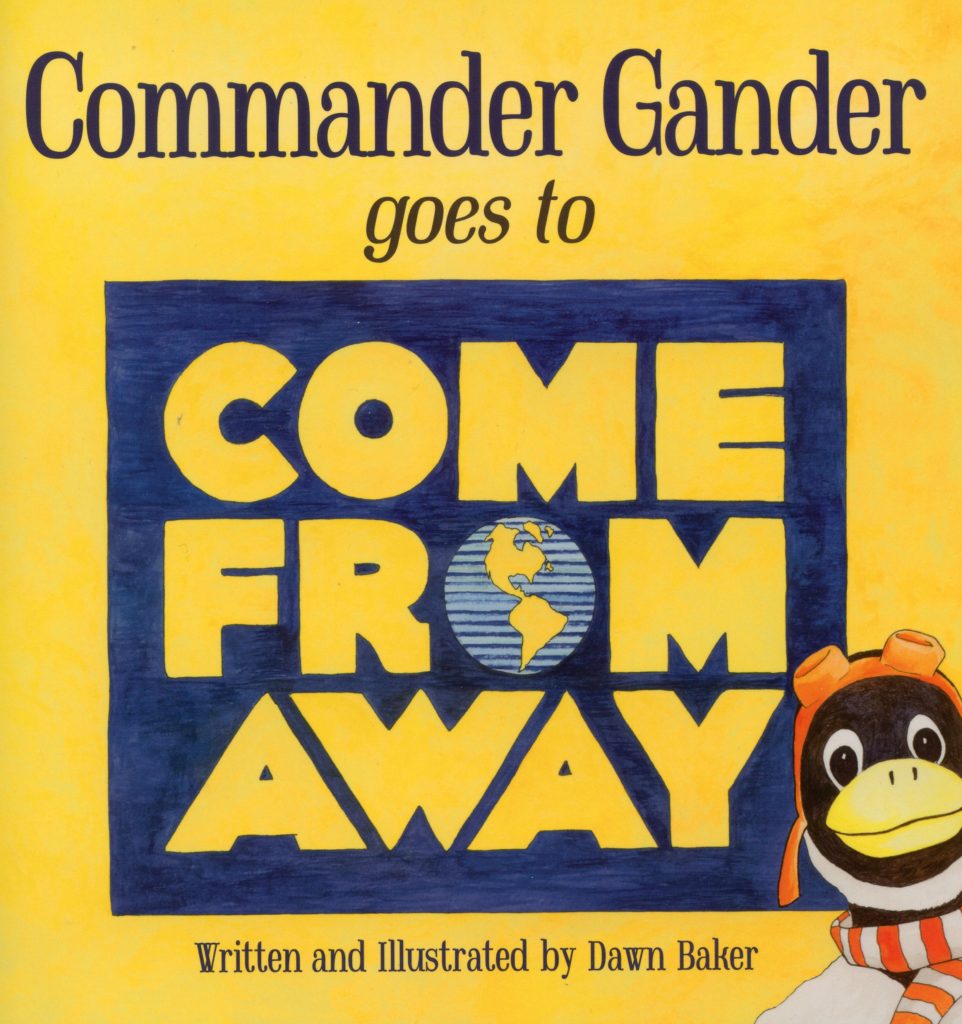
BAKER, Dawn
Commander Gander Goes to Come From Away
Pennywell Books/Flanker Press, 2019. Unp. Illus. Gr. K-3. 978-1-77117-723-8. Pbk. $14.95
Rating: E
Dawn Baker has brought us another wonderful picture book focussed on a Newfoundland event that has become known worldwide. In Commander Gander goes to Come From Away Baker revisits the events of September 11, 2001 when the attack on New York’s Twin Towers forced many planes carrying over 7,000 passengers to land in the small town of Gander in Newfoundland where they were stranded for five days.
In the book Commander Gander, a mascot of the town, helps out with holidays and community events, especially with children and was an important figure with the children who were stranded in the community in 2001. Now he is going to New York City to see the musical production “Come From Away” which was written by David Hein and Irene Sankoff to “help people everywhere remember the kindness that the ‘plane people; had been shown.” The book goes on to tell of Commander Gander’s visit to New York and his attendance at the musical where he is recognized by one of the people who had landed in Gander and gets to meet the cast of the production.
Baker brings the reality of that fateful day to young children by focussing on the good deeds and the thankfulness that resulted from the hospitality the stranded people were shown, not just in Gander but in other towns like Appleton, Gambo, Glenwood, Lewisporte and Norris Arm. The production “Come From Away” has been a smash hit, not just in New York but also in Toronto and is now playing in a variety of European and Asian venues. Having seen it myself in Toronto last fall, I can truly say it is an exceptional production which shows the true meaning of caring and reaching out to those in need.
Once again, Dawn Baker has created a beautiful book with her full-page colourful art work which perfectly complements the text. I would highly recommend it for all school and public libraries, not just in our home province but throughout Canada. 9/11 was an earth-shaking event and this book brings it to a young audience without going into the horrific details. For older readers it can be a jumping off point for more in-depth research into the happenings on that day.
Thematic Links: 9/11; Gander, Newfoundland; Come From Away
Reviewed by Victoria Pennell in Vol. 24, #5
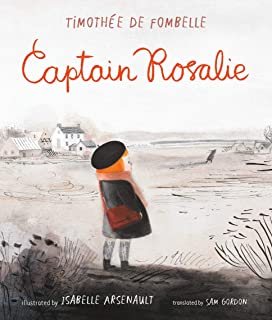
DE FOMBELLE, Timothée
Captain Rosalie
Illustrated by Isabelle Arsenault. Candlewick Press. 2019. 60p. Illus. Gr. K-2. 978-1-5362-0520-6. Hdbk. $21.99
Rating: G/E
Captain Rosalie is a heart-warming story, told through the eyes of a child. Captain Rosalie is a novella about the harshness of war, determination to overcome tragedy, grief in loosing a loved one, and courage to follow your dreams, regardless of what life throws at you.
Rosalie is a five-year old girl who is too young to belong in the class, but is allowed to sit in the back of the room and draw while the older students learn. Her mother works in a factory each day and her father is fighting in The Great War overseas. Rosalie’s voice resonates with emotions typical of her situation (fear, curiosity, determination and eventually grief). Told through her voice, readers discover Rosalie’s “secret mission”, and her adventure to conquer a task that is very important to her. Throughout the story, Rosalie uses terms and phrases synonymous with war: spying on the enemy, ranks titles of soldiers, abandoning her post, etc.; Rosalie’s world has been infused with many aspects of war, and her thoughts and words reflect the world happening around her. The author, Timothée De Fombelle, inserts nuances as well that are symbolic with war: e.g. the teacher with one arm (after returning from war), reports of what is happening on the front lines, a medal of bravery. Rosalie misses her father, and her only contact with him is through the letters he sends to his wife and the newspapers read aloud in the classroom.
Rosalie’s “secret mission” keeps her amused both at school and at home. She loves listening to her mother read the letters sent by the father. But she also knows this makes her mother sad. One day a “different” letter arrives and Rosalie’s mom isn’t the same afterwards. Rosalie’s curiosity is heightened and now that she has learned to read she knows she must read what was in that letter in the blue envelope. With the help of her “Lieutenant” she leaves school one day, rushing home to find the last letter that arrived. The result of her discovery is devastating and finally Rosalie is awakened to the loss that war creates.
Timothée de Fombelle has written a heartbreaking story that is both sad and beautiful. The author use of the voice of a child is powerful and engaging. The character Rosalie is a bright and sensitive child, but one that displays strength, bravery, determination and a curiosity typical of a young child. Other characters, such as the teacher, Edgar, and the mother are given secondary roles in the story that are very crucial to Rosalie’s discovery of the truth. The text allows Captain Rosalie to be an easy read, but one that is filled with eloquent emotions and stories. De Fombelle contrasts the darkness of war with the tenderness of the mother-daughter relationship, allowing Rosalie to be the symbol for so many children today that are affected by war, without ever stepping in a combat zone.
In the illustrations, Isabelle Arsenault brings Timothée de Fombelle’s story to life, filled with realistic emotions, subtle details and a colour palette reflective of the story’s ambiance. Muted and dark colours dominate the pages, with scatterings and shades of blue, orange and red mixed in. One strong colour is red-orange: Rosalie’s hair is red and in many of the illustrations, her hair is the only colour present on the pages. It is a contrast of the grimness of war (dark hues) with the innocence and hope in Rosalie’s world (shades of red & orange). Shades of grey are intertwined with the stark black tones, especially in the landscapes and the “space” around Rosalie as seen on the double-page spread on pages 34-35. The dark colours reflect Rosalie’s world!
Captain Rosalie is a book intended for younger children, but it could easily be read in any grade and enjoyed by adults as well. The subject matter may seem a little heavy for young children, but Timothée de Fombelle’s sensitive rendering of the themes softens the horrors of war for young readers. Rosalie could be any child in your neighbourhood, in any part of the world, at any given time in history. A charming read, Captain Rosalie is worthy of being in every school and public library as a gentle way of introducing war to young readers.
Thematic Links: War; Death; Grief; Peace; World War I (The Great War); Secret Mission; Determination
Reviewed by Carmelita Cechetto-Shea in Vol. 24, # 4
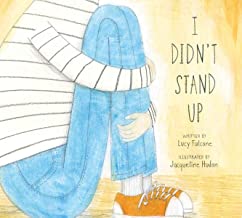
FALCONE, Lucy
I Didn’t Stand Up
Illustrated by Jacqueline Hudon. Clockwise Press, 2019. 32p. Illus. Gr. 1-3. 978-1-988347066. Hdbk. $19.95
Rating: E
Falcone’s debut picture book was inspired by the poem, First They Came, written by Martin Niemöller. The narrator in this new story for children laments the fact he didn’t stand up to the bully in his class because he wasn’t like the kids the bully was picking on. He wasn’t black or a geek, poor, or gay. He doesn’t say anything when the bully picks on the Muslim girl in his class, or the boy who walks with a cane. The narrator uses words that hurt, and words that kids would say to describe someone they were bullying (i.e. fat). The bullying takes the form of physical bullying, isolation or shunning, name calling, and embarrassment. His fear at the end of the book doesn’t come true though because all the kids who were bullied help him; they don’t try to ignore it like he did. No one stood alone.
Back material includes an author’s note about the poem and the writer of the poem, and some facts about bullying both in the past and present.
I would recommend this powerful book be in every library imaginable; school, public, and personal.
Thematic Links: Bullying; Victims; Bystanders
Reviewed by Tanya Boudreau in Vol. 24, #5
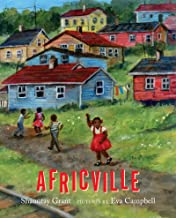
GRANT, Shauntay
Africville
Illustrated by Eva Campbell. Groundwood Books, 2018. 32p. Illus. Gr. K-3. 978-1-77306-043-9. Hdbk. $18.95
Rating: E
Africville is the title of a beautiful picture book written by Shauntay Grant. It tells the story of a Black community in Nova Scotia where comfort and love equate to being home. The book was inspired by a poem Ms. Grant wrote a few years ago while she was sitting on land once known as Africville, Nova Scotia. As a descendant of Black Loyalists, Shauntay Grant’s Africville is a love story of what had been for the people who lived there, a sense of community, of family. Readers see the community of Africville through the lens of the main character, a little girl, who wants to return to the land near the ocean, to frolic on the grass with other children, and to savour the sweet taste of the blueberries nearby. The little girl dreams about the place where her family had lived, wanting to return so that she too can feel “at home”.
The simplicity of the writing allows readers to become emotionally drawn to each word. The story focuses on the children (the hope of the future) and the community from which they descended. The children are carefree, curious, and revelling in happy memories. Regardless of where “home” is for the reader, Africville provides the reader with a sense of what home is and how important it is for everyone to remember where he/she comes from. This is the intent that Shauntay Grants wishes for each reader to take away from her story. The descriptions of the various places in the community are short and sweet, but evoke emotions of joy, laughter, anticipation and more!
Eva Campbell has created illustrations that truly make Africville (the place and the story) come alive on the pages. The deep, rich colours in each illustration are warm, vibrant and inviting to the eye; they entice the reader to engage in the marriage of the text with the illustrations, creating a visual experience of a place that meant so much to so many. The reader travels on a special journey in both text and visual memories in Africville. Ms. Campbell’s drawings allow the natural beauty of the landscape to awaken one’s memories of being home, regardless of where home lies.
Included at the end of the book is a page of information and photos of the community of Africville. The author doesn’t provide many details in the story itself about Africville’s history, so the end matter information fills in the gaps for the reader, with a description of the community and its rich, but sad, tale. Besides the additional information, there is a list of some other books on the topic of Africville, and a link to the Africville Museum. All this extra information is needed for readers, young and old, who may not be familiar with the community near the Bedford Basin in Nova Scotia, as well as shed light on the demise of a place so many called home. Africville is a delightful book for classrooms and public libraries looking for a gentle storybook as well a tribute to the history of a place that should not be forgotten.
Thematic Links: Africville; Black Communities; Culture; Family; Resiliency; Dreams and Hopes
Reviewed by Carmelita Cechetto-Shea in Vol 24, #3
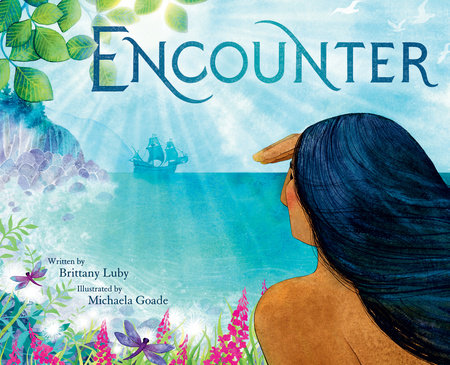
LUBY, Brittany
Encounter
Illustrated by Michaela Goade. Tundra Books, 2019. 40p. Illus. Gr. K-4. 978-0-316449182. Hdbk. $21.99
Rating: E
Told in a rotating first-person narrative, this picture book is loosely based on the real journal kept by French explorer Jacques Cartier in 1534. It imagines a first meeting between a French sailor and a Stadaconan fisher as they attempt to communicate and navigate their differences. The wise animals around them (land and sea) are attentive and comment on the similarities between the two men, pointing out areas for common ground. It is this unique shifting perspective that gives this book a new voice and message. The intent of the message is one of hope and possibility and could lead to many opportunities for discussion of differences, both historically and in contemporary times. An author’s note at the end of the book outlines the historical context as well as situates the story in the present day and provides a spring-board for further discussions as to what happened next (historical legacy of colonialism) as well as ways that this story and outcome can be adapted for our present and future encounters with those who are different from us.
Michaela Goade’s (Tlingit heritage) watercolour, pen and ink and gouache illustrations are stunning add greatly to the text.
Author Brittany Luby (Anishinaabe-kwe) is the many times great-granddaughter of Chief Kawitaskung, a leader who negotiated the North-West Angle Treaty of 1873. She is an assistant professor of history at Guelph University in Canada with an interest in social justice.
This title is highly recommended for school and classroom use. It would make an excellent read aloud with prompts for further discussion and placement within the context of Canadian history.
Thematic Links: Indigenous; Canadian History; Social Justice; Discovery Story; Jacques Cartier
Reviewed by Erin Hansen in Vol. 25, #1
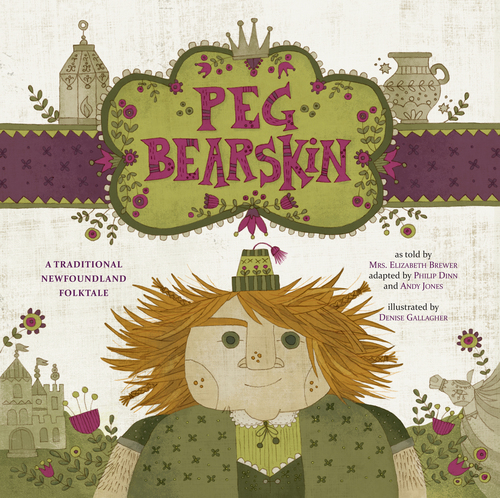
Peg Bearskin: A Traditional Newfoundland Tale
Adapted by Andy Jones & Philip Dinn from a tale told by Mrs. Elizabeth Brewer. Illustrated by Denise Gallagher. Running the Goat, Book and Broadsides, 2019. 32p. Illus. Gr. K-3. 978-1-927917-19-0. Pbk. $14.95
Rating: E
All around the world, we can find many versions of this sort of Cinderella tale, where brains trump beauty. Perhaps this makes Peg Bearskin a true book for our times, especially in light of the recent #MeToo Movement.
Peg is no beauty. She is big, hairy and ugly, but she’s also courageous and clever enough to outsmart a witch, win the approval of a king and find herself her own prince charming to live happily ever after with, even if it takes a little Shrek like action to get her there.
Luckily for us, in the past, time was taken to record these traditional tales from the out ports of Newfoundland (in this case, Placentia Bay), and the adaptors have been able to capture the feel and the dialect of the story and its rough and tumble heroine. You know where you stand with Peg. “Well, Peg said, I’d take ya and I’d stuff ya down in a bag. Then I’d take ya on the side of the road and I’d leave ya there, and I’d go off into the woods and I’d cut some hazel rods and I’d come out and I’d beat ya ’til ya meowed like a cat, ’til ya barked like a dog and … and ’til yer bones rattled like crockery ware.”
Denise Gallagher’s illustrations are interesting, albeit somewhat unexpected in their complexity. The reader is definitely compelled to go back and examine more minutely her depictions of Peg and her family and to examine the pallet of muted burgundies, browns and greens she has selected to illustrate this tale.
This is an excellent and possibly mandatory addition to the 398.2 collection in any Canadian school. Peg rocks! Highly recommended
Thematic Links: Folklore; Newfoundland; Cinderella Tales
Reviewed by Anne Letain in Vol. 25, #1

RUMBOLT, Paula Ikuutaq
The Origin of Day and Night
Illustrated by Lenny Lishchenko. Inhabit Media, 2018. 36p. Illus. Gr. Preschool – 3. 978-1-77227-180-5. Hdbk. $16.95
Rating: E
This delightful picture book is a retelling of an Inuit oral origin story about the beginnings of day and night. In the magical beginning of time, there was only darkness and Arctic fox, Tiri, thrived, as he was nocturnal and could see well in the darkness. Ukaliq, an Arctic hare, could not see well enough to hunt effectively in the darkness and longed for the light. Just as Tiri could speak magical words to bring dark into being, so could Ukaliq call forth the light. The book proceeds as each calls forth what will work for their own purposes (with Ukaliq also trying to help humans conserve food for the winter and protect it from predators like Tiri). As each animal attempts to create an environment that suits their own strength, they come to a place of cooperation and sharing to create days with periods of both darkness and light.
The story is a strong example of a legend to introduce to young readers, as well as a lesson in cooperation for the betterment of all. Lishchenko’s colour illustrations are spare and visually impacting and the use of black and white (positive and negative space) with splashes of bright yellows and other earth tones is very effective. This is a strong book for library collections.
Thematic Links: Indigenous; Northern Canada; Inuit; Legend/Fable; Inuit Mythology; Oral Storytelling; Origin Story; Animal Tale
Reviewed by Erin Hansen in Vol. 24, #5

SMITH, Heather
The Phone Booth in Mr. Hirota’s Garden
Illustrated by Rachel Wada. Orca Book Publishers, 2019. Unp. Illus. Gr. 1-4. 978-1-459821033. Hdbk. $19.95 (Reviewed from Advance Reading Copy)
Rating: E
Inspired by the true account of an ingenious coping mechanism to deal with grief, this lovely tale will resonate with children and adults alike, even if they have not been faced with the loss of a loved one.
When Japanese artist Itaru Sasaki lost his beloved cousin in Otsuchi Japan, he tempered his grief by creating a phone booth made of glass and wood, and containing an old fashioned telephone hooked to nothing. The phone, he felt, allowed the wind to carry his voice directly to his cousin.
When the 2011 Tohoku earthquake and tsunami in Japan resulted in the tragic loss of many lives, grieving citizens from around Japan made a pilgrimage to Itaru’s phone booth in order to reach their loved ones as well.
In Heather Smith’s story, both young Makio and his neighbour Mr. Hirota lose precious relatives to the tsunami, their father and daughter respectively. Mr. Hirota creates a phone booth near the ocean, feeling that through it, his voice would be carried on the wind to his beloved child. Makio, who has been unable to speak since the tragic event, is given a voice through this connection to his father, and is finally able to express his grief and anger toward the ocean. It is through this disconnected telephone that others begin to connect to their lost loved ones as well.
This beautifully lyrical story is being marketed as one of Orca’s Lead Titles, and rightfully so.
As the author of Angus All Aglow and A Plan for Pops, Heather Smith is certainly diverse in her picture book subject matters, and this story is sure to be a favourite. The gorgeous illustrations by Rachel Wada feature bold watercolours, black inks and pencils, and are inspired by traditional Japanese techniques. Highly recommended for all children’s libraries.
Thematic Links: Tsunamis; Grieving; Loss of Loved One; Japan; Healing; Empathy; Mutism; Natural Disasters; Coping Mechanisms
Reviewed by Nicole Rowlinson in Vol. 25, #1
Fiction
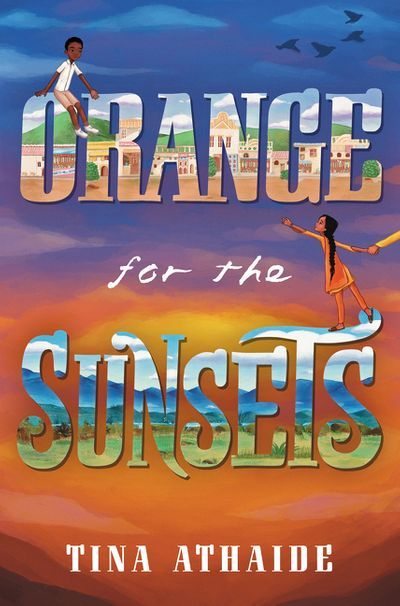
ATHAIDE, Tina
Orange for the Sunsets
Harper Collins Publishers, 2019. 359p. Gr. 6-9. 978-0-062795298. Hdbk. $21.00
Rating: E
Tina Athaide was born in Uganda and grew up in London England and Canada. She and her family left Uganda before the expulsion, but her personal experiences and those of many of her friends and family inspired her to write this story.
The two main characters in this story, Asha, an Indian girl and Yesofu, an African boy are best friends and complete opposites. The story of their friendship is set in Uganda in 1972, with Idi Amin’s expulsion of the Asians from Uganda as a backdrop. Asha lives with her family in a comfortable home. Her mother is a doctor and her father works for the ministry of tourism. They are members of a country club and drive a luxury car. Yesofu’s mother works as a servant for Asha’s family. Yesofu’s father works in the sugar cane fields. They live in Katalu, the shantytown set apart where the Africans live.
Asha and Yesofu come together at school where they are in the same class, and at Asha’s home, where Yesofu meets his mother after school. They are best friends that must face some harsh realities. The story takes place over 90 days. In that time, the Asians face the loss of their businesses and homes. When things become violent, reality sinks in. Asha and Yesofu remain friends as long as possible, but eventually, Yesofu must choose between his friendship with Asha and his loyalty to his community. Complicating matters, Asha’s father has been secretly getting Asians safely out of the country. In the end, the inevitable happens. Asha’s father is arrested and Asha and Yesofu will be forever separated. Asha and her mother flee the country leaving all their possessions behind.
The book includes a time line of the events that encompassed the expulsion of Asians from Uganda in 1972, an author’s note about the novel, two pages of black and white photos, and a bibliography.
Teachers could use this book to supplement a unit on Africa, Uganda, or refugees. It is also a good example of historical fiction.
Thematic Links: Friendship; Uganda; Refugees; Expulsion; Racism; Dictatorship
Reviewed by Elizabeth Brown in Vol. 24, #4
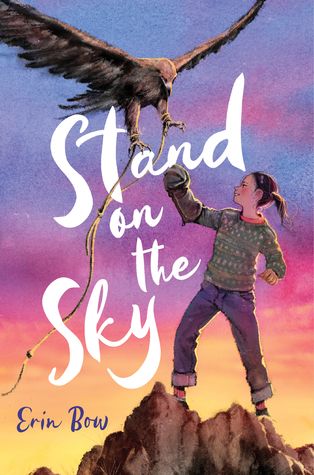
BOW, Erin
Stand on the Sky
Scholastic Canada, 2019. 306p. Gr. 5-9. 978-1-4331-6379-8. Hdbk. $21.99
Rating: E
Erin Bow writes fantasy and science fiction for young adults. She is the author of Plain Kate, The Scorpion Rules, and The Swan Riders. She has won the Kirkus Reviews Best Book Award and the YALSA Best Book of the Year Award.
The heroine of the story Aisulu lives an ancient lifestyle in modern day Mongolia, with her parents, brother, and large extended family. They are Kazakhs, a Turkic people who mainly live in Eastern Europe and the Ural Mountains. The province of Bayan-Olgii is their homeland where they practise their traditional way of life: nomadic herding, moving their animals several times a year, living in gers (a round tent) decorated with exquisite embroidery, and maintaining the custom of burkitshi, hunting with eagles. Their traditional roles are gender specific. Girls and women fetch water, milk the animals, make butter and cheese, prepare meals, embroider, and sweep the ger. Men and boys are responsible for taking the herds to pasture and back. They are also the ones who capture and train the eagles.
At the beginning of the story, we see that Aisulu does not keep within the traditional roles of the women. She does all the usual chores, but in addition she rides into the mountains with her brother Serik. On one of the occasions, they are trapped in a blizzard and later come upon an eagle in its mountain home. When Serik tries to capture the eagle, disaster strikes. The eagle attacks and both Serik and the Eagle are injured. Serik has a broken leg and the Eagle is also damaged. Aisulu rescued both, but Dulat, Aisulu’s uncle snaps the bird’s neck to put it out of its misery. Ainsulu goes back to the mountain to perform a dangerous task of rescuing the baby eagle that has been orphaned by the death of its mother.
Serik is treated at home, but when Aisulu tells her parents that she thinks Serik is hiding an illness, they whisk him off to hospital. He has bone cancer (osteosaracoma). Her family’s sudden departure with no goodbyes makes Aisulu feel abandoned, but she finds love in a new family, her uncle Dulat and his wife who treats her like a daughter.
Ainsulu has a long and difficult journey to train her eagle. She also has to win the support of the others around her, especially the men because she is breaking out of her traditional role. When she learns of the costs to treat her brother and the prize money she could win in an eagle hunting competition, her sights are set. The community rallies around her and she is successful. Her brother will receive his treatment, but again Aisulu is left behind when her family goes away. She seems to come to terms with the situation, taking comfort in her new family.
This is a beautifully written book. The details of the country, the people, and their traditions are rich and authentic. The author has exhaustively researched each fact. The characters are well developed, and the plot moves seamlessly, bringing all the elements together in an engaging way. The book includes a glossary of unfamiliar (Kazakh) words and Arabic phrases, a list of names of characters in the book, and background information from the author about how she came to write this book. Middle school students, especially the girls, will love this book. It is an original.
Teachers could use this book in a literature class to teach the elements of realistic fiction, plot, setting, and character development. It could be used as a supplement for a unit about eagles or multiculturalism.
Thematic Links: Kazaks; Mongolia; Eagles; Eagle Hunting; Family; Gender Roles; Traditional Cultural Roles; Heroines
Reviewed by Elizabeth Brown in Vol. 24, #4
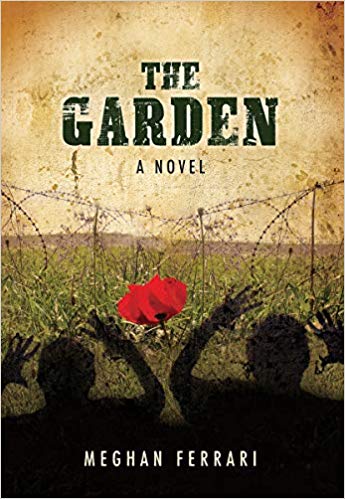
FERRARI, Meghan
The Garden
Red Deer Press, 2018. 119p. Gr. 7-12. 978-0-88995-568-4. Pbk. $12.95
Rating: E
This novel is related through alternating chapters: flashbacks to Syria during the recent conflict, and present day life in Canada. The Barakat family, father, mother and fifteen-year old Elias, have had the good fortune of a Canadian relative who sponsored them to come to Canada after they fled Syria to a refugee camp in Lebanon. But Elias has had a difficult time, between the casual racism and bullying of some of his classmates and the painful memories of his younger brother’s death. The friendship of Liling, herself an immigrant from China, and the invitation to join the soccer team enable him to cope.
This novel, for all its brevity and simplicity of prose style, is emotionally hard-hitting. Ferrari doesn’t spare her readers the painful details: the fear each time a family member leaves the relative safety of their Syrian home, the cruel hunger which they all endure, the horrific torture of children by the Syrian army, the death of Moussa, the younger brother, the debilitating boredom and scarcity of the refugee camp, the insensitivity of some Canadians. When the class bullies beat up a boy who has befriended Elias, he viciously attacks, allowing his anger to overcome him. Although their family is able to escape to Canada, they leave with the knowledge that so many of their countrymen are still unwanted refugees, unable to move forward with their lives.
Ferrari has infused this novel with extensive research into the Syrian conflict, her experience with New Canadians through her career as an ESL teacher, and her own family’s immigrant story. This is an excellent debut novel, and, it is to be hoped, a forerunner of more to come from this powerful new voice in Canadian YA literature.
Thematic Links: Sports – Syria – Civil War; Refugees;, New Canadians; Post Traumatic Stress Disorder; Empathy
Reviewed by Patricia Jermey in Vol. 24, # 3
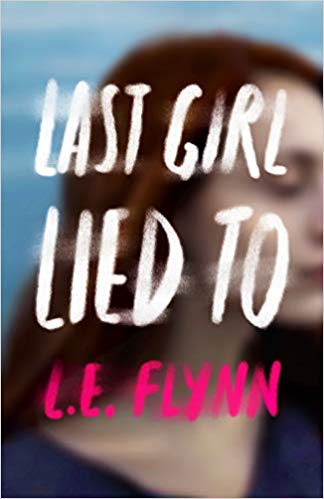
FLYNN, L. E.
Last Girl Lied To
Imprint/Macmillan Publishing Group, 2019. 347p. Gr. 11-12. 978-1-250158130. Hdbk. $23.50
Rating: E
L.E. Flynn is the author of Firsts, a Young Adult Library Services Award pick.
Fiona is in her senior year at high school and her life is unravelling. Once she was a cheerleader and friends with cheerleaders, Alison and Jenny. Her life was focused on her friends, keeping her weight in check to fit into her cheerleading uniform, sewing fashionable clothes, and her crush on Beau Hunter, a football player. She and her crowd passed their time at drinking parties, mostly at Alison’s house when her parents were away. The rest of the time, Fiona was often alone at home because her single parent mother was often away on business.
When Jenny, her best friend told Fiona that Beau Hunter had asked her out, Fiona snapped. Jenny seemed to gloat about it, even though she knew how Fiona felt because Fiona had confided to Jenny her secret love for Beau. Jenny’s excuse that Beau’s brother had just committed suicide, so she couldn’t say no, was just not enough.
At this exact moment, when Fiona ditched Jenny to head back to her car, Trixie jumped in too and became part of her life. Trixie was unconventional and the opposite of her cheerleader friends. She encouraged Fiona to indulge in her favourite foods and often complimented her. As Fiona’s weight crept up, she gave away the sewing machine and the idea of fashionable clothes. When Trixie suddenly disappears from one of the drinking parties to walk into the ocean, Fiona is the only one who doesn’t believe it is a suicide. She tries to pick up clues from others and from what Trixie has left behind to uncover the truth.
The plot is well constructed with lots of twists, turns and surprises. Who is telling the truth? Is there a connection between the last two suicides? What is being kept hidden? Answers are not revealed until the very end of the story and some questions will never be fully answered because the reader only knows what Fiona is thinking and her thoughts are very personal.
Young adults will enjoy this book, because it speaks to their lives. Relationships, both with boys and girls, social norms, parental and peer influences, choices for the future, self-esteem, and growing into adulthood are explored.
Thematic Links: Relationships; Self-Esteem; Suicide; Growing Up; Drinking
Reviewed by Elizabeth Brown in Vol. 25, #1
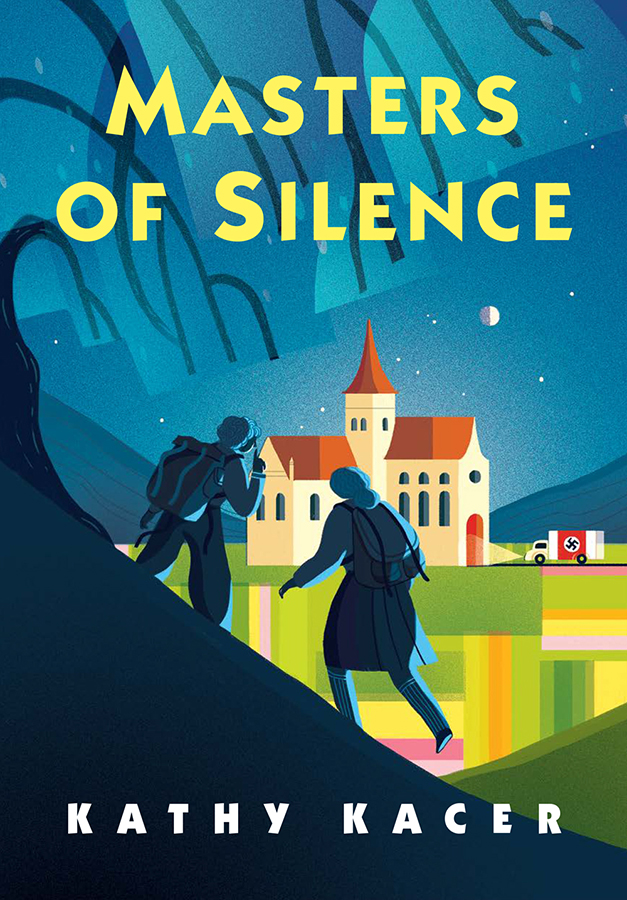
KACER, Kathy
Masters of Silence (The Heroes Quartet Series)
Annick Press, 2019. 267p. Gr. 4-9. 978-1-77321-261-6. Pbk. $12.95
Rating: E
Henry and Helen Rosenthal are brought to a convent in Southern France when their father is rounded up by the Nazis in their native Germany, and their mother determines that this may be the only way to keep them safe. The children are given new identities and the Sisters do their very best to protect the children in their care, all of whom are Jewish refugees.
Helen and Henry are deeply affected by everything they’ve experienced, so much so that Henry becomes mute and saves all of his deepest anxieties for his notebook which proves problematic. The children embrace convent life and the nuns do their best – even providing some comic respite from a mime named Marcel Marceau.
In the direct, clear style that she is known for Kathy Kacer creates a tense, believable story about the heroic work that renowned mime artist Marcel Marceau undertook as part of the French Resistance during World War II.
When the children are deemed to be no longer safe at the convent, Marceau physically leads them on a journey to Switzerland where they can live safely as Jews. It is a harrowing, gut-wrenching hike in the dark of night through treacherous terrain, and the reader is held hostage to the end wondering whether the small group will make the journey successfully.
In 2001, Marcel Marceau received the Raoul Wallenberg Medal in recognition of his acts of courage aiding Jews during the Second World War. This book is a tribute to his work and a worthy addition to any collection that is built to educate young people about the Holocaust. It is the second in The Heroes Quartet Series. Highly recommended.
Thematic Links: Holocaust; Marcel Marceau; Mimes
Reviewed by Anne Letain in Vol. 25, #1

KADARUSMAN, Michelle
Girl of the Southern Sea
Pajama Press, 2019. 224p. Gr. 4-6. 978-1-77278-081-9. Hdbk. $19.95
Rating: E
This is how the book opens:
“Three things a girl from the slum is told never to do.
Never go out after dark.
Never walk alone.
Never disobey your father.”
Nalia, her father, and younger brother live in the slums of Jakarta, Indonesia. Nalia’s mother died in childbirth and she has raised her brother Rudi from infancy. Nalia’s father has a banana fritter stand in the local market and when he isn’t drinking, makes enough to house and feed his children but not enough to pay for Nalia’s high school. She has advanced as far as she can through the public system but it ends at middle school and she wants to be a writer.
Nalia has always told Rudi stories about Dewi Kadita, goddess of the Southern Sea, cursed with leprosy on land but beautiful and omnipotent in the ocean. Her mother told her about the goddess when Nalia was a little girl and Nalia has told her stories to Rudi as well as her school teachers. The school principal asks Nalia to send a story with Rudi which she does but life intervenes and she forgets that she has sent it.
On a bus trip to pay the rent before her father spends it on drink, Nalia is thrown from a bus just before it crashes. She is assisted by a stranger who accompanies her home and begins to tell anyone who will listen that she survived so miraculously she must possess magic. He proceeds to encourage her to charge double for the now-popular “magical” fritters she is selling while her father visits their ancestral village. The father does not return and Nalia realizes that before he left, he betrothed her to the young enthusiast. Things fall apart in a big way when a mob gathers first to demand refunds for the non-magical fritters and then threatens to set fire to her for being a thief. She is saved by the old woman who tends the cemetery and then takes steps to set things right.
First, she realizes the old woman was not as fortunate as she and was disfigured by a mob attack. Second, she sets out to retrieve her father so that he can tell the enthusiast’s mother that there is no betrothal. Third, she reconnects with her best friend and together they visit the festival of the Queen of the Southern Sea. In addition to this, Nalia’s former school principal hires her as a literacy tutor so she can earn enough money to attend high school.
Author Michelle Kadarusman is Australian/Indonesian/Canadian and her insight into life in Indonesia, supplemented by her shared heritage has made this fictional story of poverty, tradition and self-determination entirely accessible and – more importantly – believable. There is a pragmatism here that transcends all the possible and imagined divisions in this story which gives it an appeal as broad as the ocean it describes.
Thematic Links: Poverty; Indonesia; Family Life; Arranged Marriage; Superstition
Reviewed by Lesley Little in Vol. 24, # 4
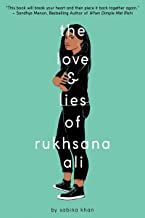
KHAN, Sabina
The Love and Lies of Rukhsana Ali
Scholastic Press, 2019. 326p. Gr. 7-12. 978-1-338-22701-7. Hdbk. $22.99
Rating: E
Well-adjusted Seattle high-school student Rukshana Ali has loyal friends, does well in school, and has been awarded a scholarship to Cal Tech. She can hardly wait to relocate there with the love of her life and study her favourite topic: physics.
The only impediments to Rukshana’s plans are (a.) She is Muslim (b.) Her loving parents are very conservative Muslims (c.) Rukshana is gay and, (d.) The love of her life is from an all-American family.
Ruckshana manages to deal with all these issues with relative ease until her mother accidentally catches the girls kissing in Rukshana’s bedroom.
After that, Rukshana’s life implodes on all fronts. Her parents take her to Bangladesh under the pretence of visiting her dying grandmother. The visit is actually a desperate attempt to find Rukshana a suitable Muslim husband in an effort to combat not just her being gay, but any rumour to that effect. Her friends, and particularly her girlfriend, are left in the dark about Rukshana’s whereabouts for days at a time and even then do not quite comprehend the seriousness of both her situation and her parents’ fear and loathing of the position into which they feel Rukshana’s predilection has placed them.
An indication of the peril that Rukshana’s parents fear is brought home to all parties when the secretly gay groom Rukshana has chosen is murdered on his way to their wedding in Dakar. Rukshana escapes the same fate because she has travelled with her brother to the airport where she had been scheduled to meet the groom as they were both planning to escape back to the United States.
Concurrent with this tragedy is the presence of a diary Rukshana’s grandmother kept during a miserable marriage she endured because she had to. Rukshana eventually realizes being gay is not the only wrinkle in the fabric of her family’s life. Some secrets need not be shared too broadly, if only to protect those who would never recover from such knowledge.
Author Sabina Khan has given an unadorned yet rich account of the machinations both for and against Rukshana’s quest to be her truest self in both her cultures. Khan’s descriptions of life in Bangladesh are striking in their veracity and intensity, as are her descriptions of a family whose history and beliefs are often at odds, not just with modern life but sometimes each other. Yet they manage to keep moving towards what they consider to be most worthy.
Thematic Links: Bengali-Americans; Muslim Girls: Lesbians; Mothers and Daughters; Identity; Arranged Marriages
Reviewed by Lesley Little in Vol. 24, #4
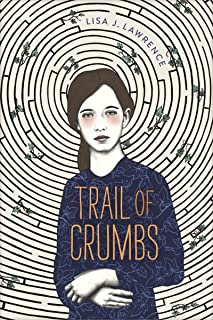
LAWRENCE, Lisa J.
Trail of Crumbs
Orca Book Publishers, 2019. 256p. Gr. 9-12. 978-1-4598-2121-7. Pbk. $14.95
Rating: E
The review copy arrived with a sticker attached that read Lead Title. The sticker was no mistake – this is an exciting YA title by a relatively new author. Lisa Lawrence’s first book Rodent also garnered a lot of attention and Trail of Crumbs which is a kind of a riff on Hansel and Gretel is also deserving of some good noise.
Greta lives in Edmonton with her father, stepmother Patty and twin brother Ash. Things have steadily deteriorated since her mother died of breast cancer seven years ago, and in the middle of twelfth grade, Greta and her family are living in a basement suite with few amenities including heat.
After a terrible and final altercation with Patty (who Greta finds burning all the family photos pre-Patty), the twins find themselves abandoned in the suite with a small amount of food and no money when Patty and their father leave. It seems apparent that their father has chosen loyalty to Patty over loyalty to his children.
Greta has also made some poor choices about whom she chooses to socialize with at school and ultimately finds herself drunk and sexually abused at a party. Deeply ashamed she keeps the details to herself. Just when things cannot appear to get any worse, they do – on both the day-to-day work of living and the social side of school. The twins have to make some really hard decisions and find both strength and resilience to continue on and move forward. Surprisingly, support comes to them from some very unlikely people and Greta and her brother grudgingly learn that there is both kindness and goodness in the world.
This is a taut page-turner read. Lawrence keeps up a very attractive pace which keeps the plot flowing. Sometimes the style is somewhat confusing in that the book switches from the present to the past without warning. That said, other features such as strong characterization for both the main and secondary characters made this a treat to read. Even though this book was about a pretty heavy-duty topic, Lawrence actually made room for some humour and love of food. Highly recommended.
Thematic Links: Sexual Abuse; High School
Reviewed by Anne Letain in Vol. 24, #3
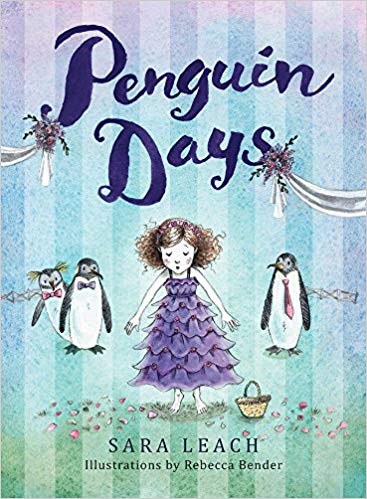
LEACH, Sara
Penguin Days
Illustrated by Rebecca Bender. Pajama Press, 2018. 100p. Illus. Gr. 2-4. 978-1-77278-053-6. Hdbk. $17.95
Rating: E
Penguin Days is a beautifully illustrated, very well written novel for beginning chapter book readers, and is a follow-up to the equally wonderful Slug Days.
Lauren, who will soon be starting Grade 3, has been asked to be a flower girl in her Auntie Joss’ upcoming wedding in North Dakota, and has mixed feelings about it. Lauren has Autism Spectrum Disorder, and as a result is very concerned about having to perform her flower girl duties, such as walking down the aisle and wearing an awful scratchy dress. Not only that, but she has to somehow put up with her lively young cousins, and travel for two whole days just to get there! Lauren’s anxieties and reactions are explored in gentle detail without being didactic, and young readers will be able to relate to her emotions regardless of their own situations.
Lauren’s voice is so authentically honest, the storyline is engaging and relevant, and the pace and reading level are perfect for beginning readers to be introduced to the subject of Autism, or to simply embracing differences. The extraordinary pencil illustrations are beautiful, and enhance the gentle emotions and narrative of the story wonderfully.
Thematic Links: Autism Spectrum Disorder; Extended Families; Weddings; Anxiety; Flower Girls; Travelling
Reviewed by Nicole Rowlinson in Vol. 24, #4
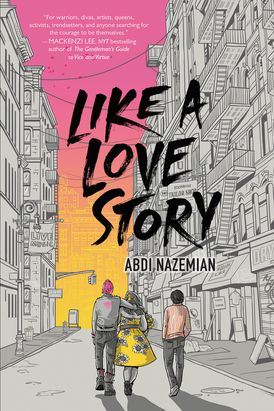
NAZEMIAN, Abdi
Like A Love Story
HarperCollinsCanada, 2019. Gr. 8-12. 978-0-06-283936-7. Hdbk. $17.99
Rating: E
Like A Love Story is probably the best LGBT YA Fiction reviewers will encounter in a long time and exists in spite of the swath of books available to teenagers as publishers try to fill this niche in the market.
Strongly autobiographical, the narrative is the story of three teenagers discovering themselves and exploring their sexuality when they meet in high school in New York City in the late 80’s at the height of the AIDS epidemic.
Reza is an Iranian boy newly arrived in New York from Toronto after his mother remarries. He is wholly in the closet but longs to be truthful to his gay identity.
Art is out, loud and proud and knows he’ll never be what his wealthy, conservative parents want him to be. His rebellion is to document the AIDS crisis through photography.
Judy is Art’s best friend and niece to Stephen, a gay activist who is quickly succumbing to AIDS. She is attracted to Reza before becoming aware that Reza is only excited about Art and the possibility of a sexual relationship with him.
All three become AIDS activists.
Abdi Nazemian is a talented screenwriter with credits on a number of well known television shows, and his writing cred really shows as he tells the story of these three friends against the backdrop of the 1989 AIDS epidemic. Reza and Art face real physical fear and Judy has to deal with the loss of a beloved uncle in a time before there was much hope for anyone with HIV.
While the dialogue of Like A Love Story is especially good, the plot line is also well maintained and reasonable.
Nazemian sugar coats very little and there’s lots of reality and very little happy ever after presented. Yet, the book is about both hope and love and will offer inspiration to every questioning or queer teenager who reads it. For that matter, it is a book that is so good that the reader doesn’t need to be LGBT to enjoy and appreciate it.
Thanks to the author for providing a wonderful epilogue. Highly recommended.
Thematic Links: AIDS; LGBT
Reviewed by Anne Letain in Vol. 25, #1
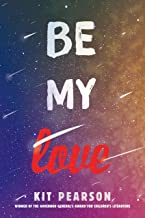
PEARSON, Kit
Be My Love
HarperCollinsCanada, 2019. 224p. Gr. 8-12. 978-1-44344-402-6. Pbk. $14.95
Rating: E
Be My Love is a classic coming of age novel with a twist by the award winning and always reliable, Kit Pearson.
Set in the very early 1950s, this is Maisie’s story. Maisie has just finished grade nine in Duncan BC and is desperate to get to Kingfisher Island to spend the summer with her best friend and cousin, Una as she has done ever since she was small. Things have not been good at home since her father, an Anglican rector, returned from service in Holland in WWII. She cannot wait to get away from her father’s depression and her mother’s desperation.
But all is not the same this summer as Una has arrived from Vancouver and has changed into a sophisticated young woman beyond the games that she and Maisie had always enjoyed. She has discovered boys and is infatuated with David Meyer who has been invited to the Island because he has recently suffered the loss of his father. With delicate foreshadowing, Pearson makes it quite clear that Maisie’s rejection by Una is much bigger than it first appears, and that Maisie is also conflicted by her own feelings towards boys in general.
Maisie’s anger over the circumstances of the summer lead to an interesting plot climax and Pearson provides a very satisfying and surprising ending that provides comfort and assurance to both Maisie and the reader.
Kit Pearson is a strong writer with an attractive direct style. If there is to be any criticism of this book, it may be that it lacks “diversity” and it is indeed largely WASP, with both Maisie’s father and grandfather being Anglican ministers. Although, it is set in a historical context, it is largely antithetical to the British Columbia of today. Highly recommended for secondary school libraries.
Thematic Links: LGBTQ; British Columbia
Reviewed by Anne Letain in Vol. 24, #3

TERRANA, Diane
The World on Either Side
Orca Book Publishers, 2019. 276p. Gr. 9-12. 978-1-4598-2217-7. Pbk. $14.95 (Reviewed from Advance Copy)
Rating: E
The World on Either Side is a heart wrenching young adult novel about sixteen-year-old Valentine whose world has been turned upside down in so many ways. After her boyfriend dies at a football game, she stops “living”, she refuses to go to school, avoids her friends and most days does not leave her bed. Told in the first person, readers discover a teen struggling with life, trying to understand her boyfriend’s death, but mostly trying to just survive without the pain. Valentine’s accidental drug overdose is the catalyst for her mother to realize she needs to act quickly, so Valentine and her mother move to Thailand; the mother is hoping the additional space away from the scene in their hometown will be enough to help Valentine heal, because she won’t forget what has happened. After arriving in Thailand, Valentine and her mother set out on a jungle trek where they meet others who join them on this adventure. While swimming one day, she meets Lin, a young elephant keeper.
The author’s depiction of the scene is very charming, descriptive and vivid; readers can truly visualize Valentine swimming in the water, with a group of elephants basking around her. As the adventure continues, Valentine and Lin’s friendship grows. One day, they stubble upon an elephant massacre and suddenly realize that despite the beauty of the jungle, they must be very careful, especially since they seem to have found an orphan elephant calf who they must now take care of. The baby elephant is injured a result of the brutal massacre the pair stumbled upon. As the friendship flourishes, Lin opens up to Valentine, telling her some things about his previous life and of the things he was forced to do. Valentine is shocked, even to the point of not knowing if she could ever forgive Lin for his actions. Eventually, Valentine discovers that forgiveness is a give and take quality and after encounters with other dangers, readers are wondering if Valentine will ever forgive herself.
Diane Terrana uses subtle humour in many of her scenes; for example, the use of the name “Tinker Bell” for Valentine’s elephant certainly makes any reader chuckle, even if not out loud. How can the name of a very tiny fairy compare to the massive size of an elephant? But when the elephant fears Valentine is in danger, the authors purpose for this name is clear: Tinker Bell (a character in the Disney movie “Peter Pan”) was a caring fairy, just like the elephant Valentine is riding on. Throughout the book, the author includes poetry from various poets (e.g. Edna St. Vincent Millay, Sylvia Plath, Pablo Neruda, etc.); often the passages from these poets are reflective of the character’s emotions and journey at that moment. These reflective words provide a deeper meaning and importance for the reader as to the journey each character is experiencing. The author also includes a reference to child soldier Ishmael Beah’s memoir A long Way Gone. Readers will cheer for Valentine and Lin as they proceed through each danger and moment on their jungle adventure, hoping that both reach a sense of peace and contentment inside.
The World on Either Side is a powerful novel about love, heartbreak and forgiveness. Readers will be immersed into a place where despair and turmoil seem to dominate the landscape. Many of the characters in this book, both primary and secondary, struggle with forgiveness, a necessary forgiveness towards others and ultimately for themselves. The reoccurring theme of realizing that the future (of the characters and the readers too) will only be complete if all learn to heal first from the past before being able to move on; it is a belief that is braided in each storyline, each character, and each heart. Diane Teranna has created a complex novel filled with many issues and anguish, where the reader will question many aspects of human existence (e.g. morals, responsibilities, choices, etc.) along the path to finding love and courage within one’s self. The World on Either Side is a book readers will not soon (if ever) forget. If ever there was a book that grabs the reader from the opening scene, The World on Either Side is the prime example for other authors to aspire to. The World on Either Side will be a difficult book to put down once you open the cover and begin your reading!
Thematic Links: Thailand; Elephant Poaching; Travelogue; Genocide; Grief; Friendship; Courage; Love; Healing; Self-Discovery; Child Soldiers; Depression; Compassion
Reviewed by Carmelita Cechetto-Shea in Vol. 24, #5
Non-Fiction

BOWLES, Stella with Anne Laurel Carter
My River: Cleaning up the LaHave River
Formac Publishing, 2018. 96p. Illus. Gr. 4-7. 978-1-4595-0551-3. Pbk $16.95
Rating: E
My River: Cleaning up the LaHave River is the true story of how a Nova Scotian student, Stella Bowles, became a successful environmental activist. Stella and her family live on the LaHave River in Nova Scotia. Concerned about the contamination of the river, Stella learned how to conduct scientific studies on the fecal bacteria levels of the La Have River.
Many residents by the river use straight pipes “Pipes that let you flush what’s in your toilet straight into a lake or ocean or river.” The story is about how Stella takes this simple and, at times, gross information about “poop” and eventually convinces governments to invest in a $15.7 million cleanup and introduce legislation banning straight pipes.
The book is written in an engaging manner. It takes the reader through a two and a half year journey from the simple beginnings of a grade 6 student working on a science fair project to a sophisticated activist using social media to educate the public and influence government. The reader is introduced to Stella’s family and mentor Dr. Maxwell. The story is at times light-hearted describing the jokes of Lennie, Stella’s father and at times serious describing debates at a public forum meeting. The text is supplemented with many relevant photographs, and informative sidebars and is written in an appropriate manner (narration by Stella) for the intended audience.
My River: Cleaning up the LaHave River is highly recommended for both school and public libraries. It is a positive example of what an individual can do for the betterment of a community while also gaining a sense of personal achievement.
Thematic Links: River Pollution; Waste Water Treatment; Science Fair Projects; Environmental Activism
Reviewed by Laura Reilly in Vol. 24, # 3
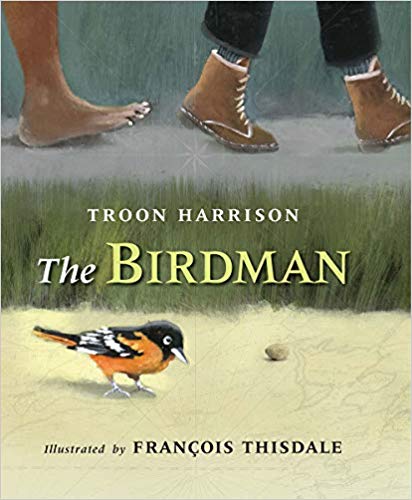
HARRISON, Troon
The Birdman
Illustrated by François Thisdale. Red Deer Press, 2018. 44p. Illus. Gr. 1-4. 978-0-88995-506-6. Hdbk. $24.95
Rating: E
This book looks at the life of Canadian ornithologist and abolitionist Alexander Milton Ross, who over the course of several years helped African American slaves escape slavery in the American South via the Underground Railroad. Under the guise of studying the birds found on the many Plantations that dotted the countryside, he was able to freely wander the area without suspicion, all the while letting slaves know about the Underground Railroad and how to travel along it without getting caught as they made their way north to freedom.
This book is an excellent resource for those studying the Canadian connection to the Underground Railroad and those people that helped the slaves that travelled along it. Also an excellent way to learn about a lesser-known person in the fight to end slavery.
Thematic Links: Abolitionists; Alexander Milton Ross; Ornithologists; Fugitive Slaves; Slavery; Underground Railroad; Canada – History
Reviewed by Alana Schlotter in Vol. 24, # 4
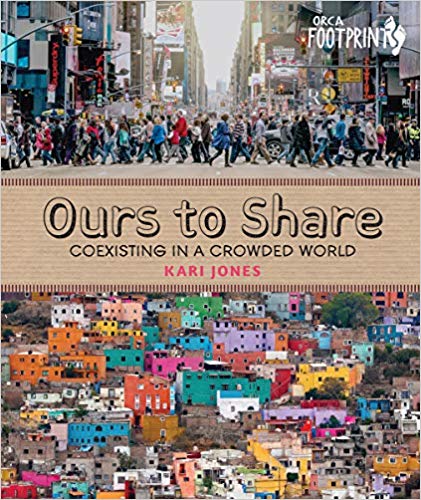
JONES, Kari
Ours to Share: Coexisting in a Crowded World (Orca Footprints Series)
Orca Book Publishers, 2019. 48 p. Gr. 3-7. Hdbk. 978-1-459816343. $19.95
Rating: E
The population of the world has grown exponentially since the beginning of human civilization. In Ours to Share: Coexisting in a Crowded World, Kari Jones explains the history of how population growth has impacted on every aspect of our world, from human conflict to pollution of important ecosystems. The first chapter, “Shaping the World,” lays out the history of how humans built cities and adapted their environments to accommodate growing populations. The second chapter, “Sharing the World,” addresses how overpopulation relates to human rights, poverty, and social inequality. The third chapter, “Whose World is This?,” discusses how human overpopulation impacts other animals around the world. The final chapter, “Sharing Our Lives,” provides examples of how regular people have made an impact in their communities and helped solve some of the problems addressed in this book. Ours to Share is the latest addition to the Orca Footprints Series by Orca Book Publishers, and it does not disappoint.
The author, Kari Jones, does not shy away from discussing current issues such as the crisis on the United States-Mexico border and the lack of clean water in Canadian First Nations. Jones clearly explains how these crises and others relate to overpopulation, and encourages readers to learn more and do their part. This book covers a broad range of topics like pollution, endangered species, the importance of education, colonization and reserves, and more. However, all of these topics are well explained and clearly tied to the central topic of overpopulation, making for a fascinating and educational read. An informative glossary and list of resources is included, making it easy for readers to learn more.
While this book is aimed at middle-grade readers, it would make a great introduction to the topic of overpopulation for readers of all ages even adults. Ours to Share is a well-written and timely book, making it an excellent addition to the Orca Footprints Series.
Thematic Links: Overpopulation; Endangered Species; Ecosystems; Natural Resources
Reviewed by Alice Albarda in Vol. 25, #1
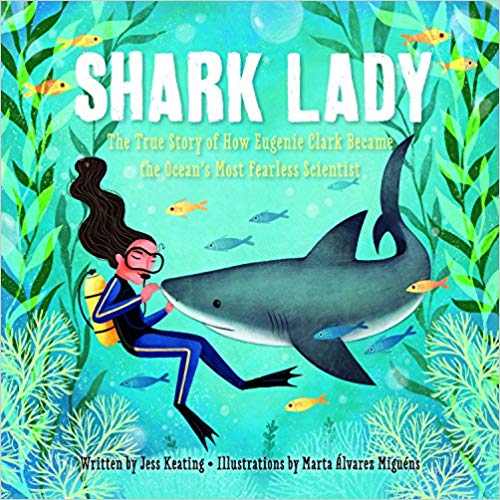
KEATING, Jess
Shark Lady: The True Story of How Eugenie Clark Become the Ocean’s Most Fearless Scientist
Illustrated by Marta Alvarez Miguens. Sourcebooks Jabberwocky, 2017. 40p. Illus. Gr. K-2. ISBN 978-1-4926-4204-6. Hdbk. $24.99
Rating: E
When she was a little girl, Eugenie’s favourite animals were sharks. She read books about sharks, visited the aquarium, and imagined what it would be like to live under the sea. Unlike most people, Eugenie saw sharks as beautiful creatures rather than mindless beasts. As she got older, Eugenie was determined to study zoology despite those who thought that a woman couldn’t succeed in that field. Eugenie’s love of sharks grew into a lifelong career studying those misunderstood animals and making scientific discoveries!
Shark Lady: The True Story of How Eugenie Clark Became the Ocean’s Most Fearless Scientist is a biographical picture book about ichthyologist Eugenie Clark, who was known for her research about sharks. Clark’s story is a story of smashing stereotypes about both women and sharks. Clark proved people wrong when they believed that a woman couldn’t succeed as a scientist, and she also showed people that sharks weren’t just aggressive, unintelligent beasts. This is an inspiring story for kids who want to become scientists like Clark. It’s especially inspiring to read a story about a female scientist, as women continue to break barriers in scientific fields. For readers who love sharks and other ocean life, this book has plenty of factual information, like fun facts about sharks and endpapers with labelled illustrations.
Shark Lady is an example of a high quality biographical picture book that will inspire and entertain readers.
Thematic Links: Sharks; Zoology; Women in Science
Reviewed by Alice Albarda in Vol. 24, #5
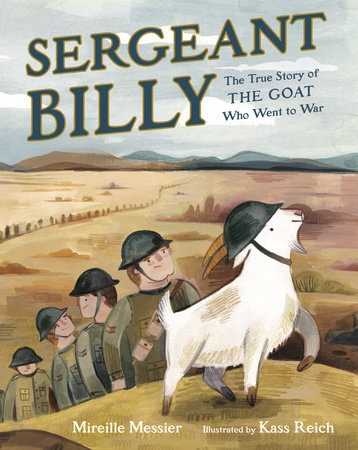
MESSIER, Mireille
Sergeant Billy: The True Story of the Goat Who Went to War
Illustrated by Kass Reich. Tundra Books, 2019. Unp. Illus. Gr. K-3. 978-0-7352-6442-7. Hdbk. $21.99
Rating: E
Many people are familiar with the story of Winnie the young bear who was taken from White River, Ontario to the training grounds in England during World War I by Captain Harry Colebourne and later became the impetus for A. A, Milne’s book Winnie-the-Pooh. However probably not many are familiar with the story of Sergeant Billy, a goat from the Canadian prairies who went to the battlefields of France during the same war.
This book tells the true story of how a group of soldiers who made a stop in the small prairies town of Broadview, Saskatchewan, on their way to fight in World War I, approached a young girl names Daisy Curwain and asked to borrow her pet goat to take overseas with them. They book tells how Billy the goat became their mascot, how they smuggled him to England and later to the battlefields of France where Billy proved himself as a valuable asset to the Fighting Fifth where he was known as Private Billy. As time progressed Billy became even more valuable as he captured an enemy guardsman and “boldly saved the lives of three soldiers by head-butting them into a trench seconds before a shell exploded right where they had been standing.” He was promoted to Sergeant and decorated with the 1914-1915 Mons Star, the British War Medal, and the Victory Medal and was given an embroidered blue plush coat emblazoned with sergeant’s stripes. After the war Billy returned to Daisy Curwain in Winnipeg and lived several more years. After his death Bill was stuffed and mounted and displayed in the Saskatchewan Legislative Building. His body was eventually returned to Broadview, where he still holds a place of honour in the Broadview Museum.
This book is well written with large colour illustrations depicting life on the battlefields during World War I. The presence of the goat and his story make this book quite good to use with young children without being explicit about the horrors of war. It would be a good introduction to the topic of World War I for young children especially around November 11 when we celebrate the end of that war.
Thematic Links: World War I; Sergeant Billy; Mascots
Reviewed by Victoria Pennell in Vol. 24, #5
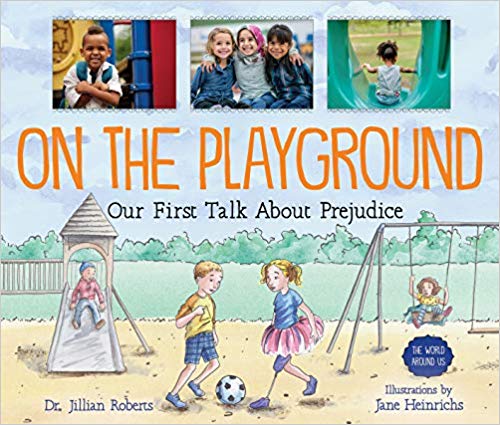
ROBERTS, Dr. Jillian
On the Playground – Our First Talk About Prejudice (The World Around Us Series)
Illustrated by Jane Heinrichs. Orca Book Publishers, 2019. 32p. Illus. GR. K-3. 978-1-459820913. Hdbk. $19.95
Rating: E
This non-fiction title confidently and skilfully tackles the issue of prejudice for our youngest readers. It is the newest title from The World Around Us Series by Dr. Roberts, a child psychologist. The book gently and carefully draws distinction and clarification between the terms harassment and prejudice and defines prejudice by gently breaking it into categories including racism, sexism, homophobia, ageism and ableism. Many carefully worded examples are provided and are accompanied by colour photos and illustrations. Diversity is discussed as well as examples of positives coming out of acts of prejudice such as pink shirt day (anti-bullying). Children are given some concrete examples of ways to stand up to prejudice as well as encouragement to explore respect and acceptance through inclusivity.
This would be an excellent title for classroom, personal, school and public libraries.
Thematic Links: Racism; Ableism; Sexism; Diversity; Inclusion; Bullying; Discrimination; Prejudice
Reviewed by Erin Hansen in Vol. 24, #4
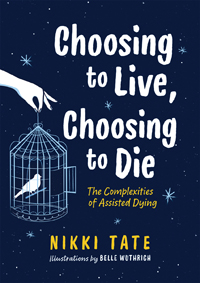
TATE, Nikki
Choosing to Live, Choosing to Die: The Complexities of Assisted Dying
Illustrated by Belle Wuthrich. Orca Book Publishers, 2019. 172p. Illus. Gr. 9-12. 978-1-45981-889-7. Pbk. $19.95
Rating: G/E
Young people are often eager to talk about and learn about personal freedoms. One of the least-discussed personal freedoms is the right to die, the subject of Nikki Tate’s new book, Choosing to Live, Choosing to Die. While readers whose lives are just beginning may not imagine a book about how to think about medically assisted death has much to do with them, in fact the book tackles an urgent topic that goes to the core of rights discourses and invites readers to move beyond platitudes and superficial notions.
Tate starts the book with a clear foundation: everyone will die one day, but we don’t necessarily control how or when it will happen. Perhaps we should. She then brings the question of choice into focus by introducing the experience of her own mother’s difficult death. This experience becomes a touchstone as Tate builds out her discussion. She defines key terms, sketches a historical context for questioning the right to die, and presents cases for readers to consider. She draws in philosophy and religion as well as legal and international perspectives on medically assisted death. Tate covers a remarkable amount of ground in a compact book (generously supported by graphics) and leaves space for readers’ own contemplation and consideration.
Medically assisted death is a difficult, important topic, and Tate handles it gracefully. Choosing to Live, Choosing to Die may be controversial reading in some communities, but teens (and adults) need opportunities for the critical thinking and personal reflection that the book requires. I hope it finds a broad readership.
Thematic Links: Ethics; Death and Dying; Religious Beliefs; Social Justice; Rights and Freedoms; Choice
Reviewed by Leslie Vermeer in Vol. 25, #1
French
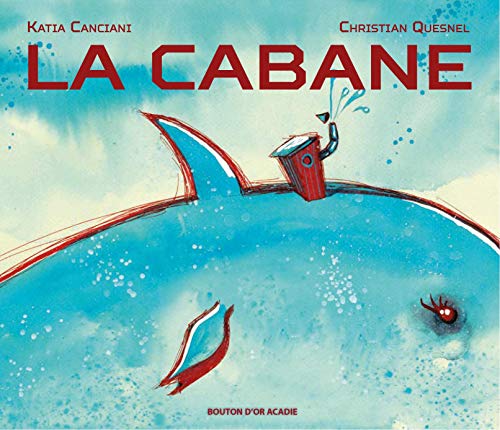
CANCIANI, Katia
La Cabane
Illustrated by Christian Quesnel. Bouton d’or Acadie, 2019. 24p. Illus. Gr. K-2. 978-2-89750-147-1. Pbk. $10.95
Rating: E
In the book, La Cabane, we meet Alphonse, a man who builds a beautiful ice-fishing hut. He settles into his hut and patiently waits to catch some fish, but the fish never come. He can’t even catch any junk floating in the sea! He is unlucky. Soon, there is a problem. Spring is coming, and the ice begins to melt. The ice on which his hut is sitting breaks away and begins to float out to sea! But Alphonse doesn’t realize it, because he has fallen asleep.
He wakes up to find himself beside a giant ship in the ocean. The ship has broken down, so Alphonse offers a section of his hut to help the ship’s captain. Next, Alphonse finds a woman trying to save a fish; he gives her part of his hut’s roof for shelter. Then, Alphonse meets a family who has lost its house in a hurricane. To them, Alphonse gives what remains of his hut. Suddenly, Alphonse is floating away on a tiny ice floe in the ocean. Now it is Alphonse who needs saving. Luckily a passing whale returns Alphonse to his home. Instead of being named the best fisherman, his friends think he is the best storyteller… maybe they don’t believe his amazing tale!
This is a lovely book about generosity. Alphonse is not having much luck fishing, but he is finding meaning in his meandering voyage through the ocean by sharing his precious hut with the people he meets. This book can spark discussions about sharing what we have with others and helping those in need. Readers can also talk about the lesson that sometimes life is about the journey and not the destination. Alphonse really wanted to catch a fish, but he discovered that even without meeting this goal, his trip was successful. This book would be a wonderful addition to a classroom or library.
Thematic Links: Generosity
Reviewed by Erin Dagenais in Vol. 24, # 4
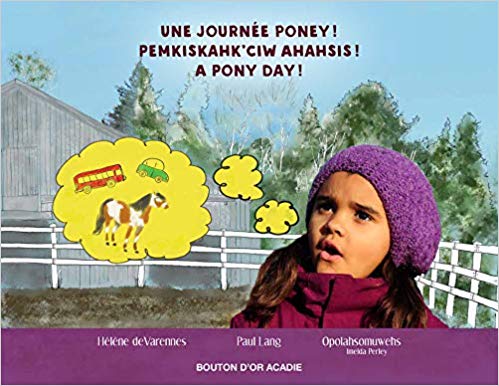
DEVARENNES, Hélène
Une journée poney!
Illustrated by Paul Lang. Bouton d’or Acadie, 2018. 56p. Illus. Gr. K-2. 978-2-89750-140-2. Pbk. $14.95
Rating: E
This book is very special because it is told in three languages: French, English, and Wolastoqey, the language of the Wolastoqiyik. It tells the story of Josephine, a young girl who spends one day a week – her favourite day of the week – with her grandpa. Her grandpa has ponies on his property and they always come to Josephine when they hear her voice.
On this particular day, Josephine’s grandpa tells her she is now big enough to ride one of the ponies. She thinks he’s joking, and she doesn’t understand how someone can “ride” a pony like they ride on a bus! She is even more confused when her grandpa tells her the pony will take her directly to the pond – how will it know where to go? And how would she stay on the back of a pony? Couldn’t she fall off? What will happen if it rains? Her worries compound, but her grandpa just laughs, gives her a helmet, and leads her to the ponies. She is delighted to discover that the pony has a seat (a saddle) and “footstools” for her feet (stirrups). Together, Josephine and her grandpa take the pony down to the pond to visit the ducks.
This is a very sweet book about the trusting relationship between a young girl and her grandfather. Because this book is offered in three languages, it crosses cultural boundaries and will help children see that they are all similar, no matter where they grew up or what language they speak. Teachers and caregivers can help kids talk about the special bonds the kids have with their own friends and family, and they could write stories and draw pictures of their family traditions.
Readers can also visit the publisher’s website to hear the audio book spoken in Wolastoqey. Teachers and caregivers can also access the website for the book, and invite readers to listen to the audio book in Wolastoqey.
Thematic Links: Ponies; Family Relationships
Reviewed by Erin Dagenais in Vol. 24, # 4
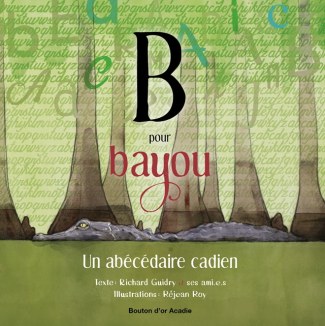
GUIDRY, Richard et.al
B pour Bayou
Illustrated by Réjean Roy. Bouton d’or Acadie, 2019. 71p. Illus. Gr. 5-6. 978-2-89750-161-7. Hdbk. $19.99
Rating: E
This alphabet book is intended for older audiences with an interest in Francophone culture. The book highlights terms and phrases from the Cajun culture of Louisiana. Poems, recipes and personal stories are included along with linguistic flares of the local dialect. The words selected were specifically chosen and meaningful to Richard Guidry, to whom the book is dedicated. Readers will discover cultural relevance they may not be familiar with, such as the words “élouise”, “grègue” and “indigo”, and the tragic events of hurricane Katrina.
Published in collaboration with the University of Louisiana at Lafayette, this work represents an exceptional opportunity for immersion students to gain an appreciation for a Francophone culture to which they may not otherwise be exposed. Written in authentic Cajun dialect, the descriptions give a unique perspective of life in the Southern United States and how it relates to Acadian Francophone culture. The detailed and heavily stylistic illustrations, by Réjean Roy, add phenomenal contextual clues to the meaning of the text. Readers will need to engage their deductive reasoning to decipher the meanings of the expressions and idioms presented. A magnificent addition to any elementary level classroom or school library, this edition is highly recommended for use in an educational environment.
Thematic Links: Cajun Culture; Louisiana
Reviewed by Veronique Lavoie in Vol. 25, #1
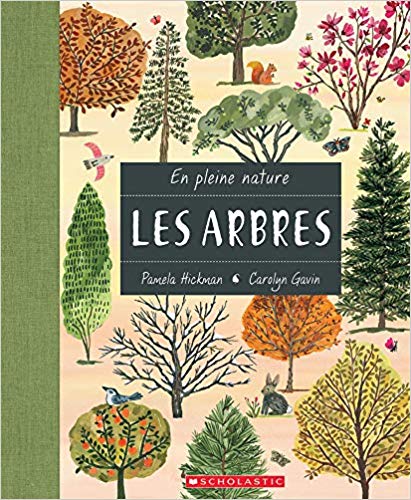
HICKMAN, Pamela
En Plein Les Arbres
Illustrated by Carolyn Gavin. Translated by Louise Binette. Éditions Scholastic, 2019. 32p. Illus. Gr. 2 up. 978-1-4431-7384-1. Hdbk. $18.99
Rating: E
“ …c’est que les arbres occupent déjà une place
important dans ta vie.”
En pleine nature Les Arbres by Pamela Hickman is a magnificent guide to the life cycle of a tree. Starting with introducing children to the parts of the tree including new or familiar words and descriptions such as “Les racine, La Couronne…”.
The author then explains the two groups of trees, types of leaves, fruit, and the science behind “Pourquoi feuilles sont-elles vertes?”
The tree investigation doesn’t end there, Hickman also shows us how to calculate the age of a tree and what happens to a tree when it dies.
Instead of putting all four seasons in one page, as other books may have, Hickman dedicated a double page explanation of each season from “ La pollination” in spring, the fruit and nut growth in summer, changing of colours in autumn to even “La sève sucrée” in winter. Furthermore it includes a map “Les regions forestières” in North America including “principales espèces d’arbres”.
One of the fun and fascinating sections is the “Un arbre grouillant de vie” that showcases the amazing life within and around the tree.
There is also a section for the newly minted arborists to have fun with some investigative work of their own in “Observations des arbres pour les débutantes”, including silhouettes of leaves and various fruits and flowers for children to guess using their newly acquired knowledge.
Towards the end there is a section on strange trees, endangered species and how to “Planter un arbre”.
All of the information would not have come alive if it wasn’t for Carolyn Gavin’s beautiful nature illustrations, accurate and lively with a flair of whimsy that draws the child or even adult to reflect, examine and turn to see the next section with great thirst. The illustrator seems to have used a combination of poster/watercolour paints and graphic markers for the majority of the illustrations and digital colour fill for the maps and silhouettes. A beautiful example of her work is reflected in the “Un arbre grouillant de vie” with a majestic tree in the centre of the double page, bringing together animals, birds, flowers, fungus, insects and all other wonderful and amazing parts of mother nature.
En pleine nature Les Arbres is a wonderful tableau of how life giving a tree can be. This book is not just a book for science projects, but a book that should be in every child’s home or school library. This book should inspire children to go outdoors to enjoy nature, or if it’s too cold, then open the book and take a stroll through nature! Also available in English.
Thematic Links: Trees; Seasons; Life Cycles; Nature/Biology; World Map; Animals; Forests; Leaves; Fruit/Nuts
Reviewed by Lara Chauvin in Vol. 24, #5
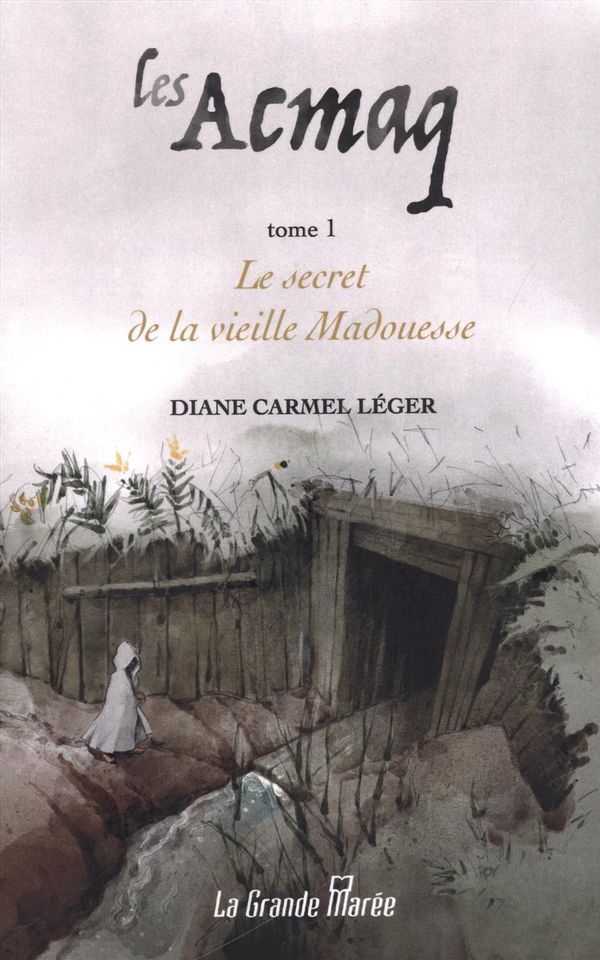
LÉGER, Diane Carmel
Les Acmaq – tome 1 – Le secret de la vielle Madouesse
Illustrated by Réjean Roy. La Grande Marée, 2018. 215p. Illus. Gr. 4-7. 978-2-349-72369-7. Pnk. Price:$15.95
Rating: E
When you first get into it, Diane Carmel Léger’s Les Acmaq reads like a charming book about Acadian/Mi’kmaq culture and a relationship between a great-aunt and her young nephew. But as the plot develops the great-aunt nicknamed la vieille Madouesse and her nephew named Benoît encounter a mysterious group of fairy-like creatures who have taken up residence in an old Acadian dike termed an aboiteau. The fairies are in desperate need of assistance, and shall enlist the help of Benoît and Madouesse in order to save their small society and way of life.
Benoît is a Quebecois who has recently moved with his family to New Brunswick. He finds himself having a difficult time adjusting to life in an town that is predominately Acadian. Not only is he is harassed at school for his strange accent but it would seem he lacks an adult ear to divulge his difficulties. His father travels a great deal and his mother is busy raising his younger sister. After a family conflict Benoît takes out the family ATV without asking permission. Riding in some of the back trails around his house he is forced to avoid a strange bipedal creature that walks in front of his path. After crashing the ATV and injuring himself Benoît will spend some time with his great-aunt Madouesse.
Much of the book focuses on the bond that develops between Benoît and Madouesse, for Benoît is hesitant at first, having heard vicious rumours of her strict manners but eventually he comes to appreciate her wisdom and knowledge of Acadian culture. After hearing Benoît’s description of the creature that he encountered, Madouesse relates stories of her childhood which include strange encounters with caped fairies who reside in the marshes under the cover of fog. The two of them will seek these fairies out and eventually converse with them, and finally help them in an important quest to save their people.
Les Acmaq is an excellent book for learning about Acadian/Mi’kmaq culture, especially the intricacies of a language that takes its roots from both linguistic heritages. Léger consistently inserts and italicizes words, describing their meaning and providing an informative glossary at the back. In one such example a fairy uses the word “bénaise” to Benoît’s bemusement. Madouesse then explains the origin of the Acadian word by instructing him that it is “le vieux mot français pour content” and further research into the glossary will enlighten the reader into finding out that the Acadian word is actually “Déformation de “ bien à l’aise” signifiant: content.” The book therefore serves as an excellent educational device via a fantastical adventure and is the first in a series that should keep a young reader captivated and interested in reaching its conclusion.
Thematic Links: Acadians; Mi’kmaq; Quebec; Family; New Brunswick; Canada; North America, Historical Fiction, Fantasy
Reviewed by Zachary Chauvin in Vol. 24, #5
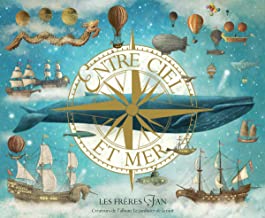
LES FRÈRES FAN
Entre ciel et mer
Translated by Hélène Rioux Éditions Scholastic, 2018. 40p. Illus. Gr. K-4. 978-1-4431-6894-6. Hdbk. $21.99
Rating: E
“Est-il enfin arrivé au lieu décrit dans les histoires de son grand-père?”
Magnificent, enigmatic, transcending, beautiful, atmospheric are some of the words to describe Entre Ciel et Mer by Les frères Fan (the Fan Brothers).
The dynamic author/illustrator duo have created a mesmerizing journey for the senses with this astounding picture book that takes one into magical lands above and beyond the sky and the sea as suggested in the title.
A little boy named Felix nostalgically remembers his grandfather that would have turned ninety years of age on this particular day. In honour of him, Felix decides to build a boat as an aide for his great adventure out to sea. After working so hard on the cubby-boat that he builds near his home on the seashore, Felix decides to take a nap where he wanders into a magical dreamland. “Le voyage a commencé!”
Together with the enchanting and exquisite graphite illustrations rendered digitally with antique colour schemes, we float into each scene like we are experiencing it ourselves. We see Felix’s boat in a distant sea with massive cloud formations of animals and objects like anchors and smoking pipes. A grand wise golden fish, assumed to be his grandfather or a sage of sorts with a rather thick moustache and beard guide Felix through the atmosphere where he questions “Sais-tu où le ciel et la mer se rencontrent?”
We are left wanting to follow Felix as he continues to pursue the majestic golden fish as he ends up in a sea library circulated by many exotic birds. The haphazard pile of books reveal the spines of some of the greatest literature that dates back many decades as old or older than his grandfather. We see the likes of Moby Dick, The Odyssey, Finnegan’s Wake, The Secret Garden and more. Felix continues on, floating around gigantic sea shells and luminescent jellyfish, where many symbols appear indicating his grandfather’s life experiences from zeppelins, hot air balloons, to the emblematic cultural icons like Asian dragons, gigantic blue whales, koi fish and more.
From ethereal dreamlands to the infinite deep sea Felix realizes where everything merges and becomes the life story of his beloved grandfather. Eventually, the golden fish swim into the moon as Felix finally bids “…au revoir” as he “…entend une voix qui ‘l’appelle au loin…”. His mother shakes him awake “J’ai préparé le plat favori de grand-papa.” The stars were already appearing as he opens his eyes and Felix ponders the “…magique entre le ciel et la mer.”
Experience a dream outside of a dream and drift to an infinite land of imagination in Entre Ciel et Mer by the Fan Brothers. A keepsake, a classic that should be in everyone’s library for young or old!
Thematic Links: Grandparents; Family; Cloud Formations; Sea; Landscapes; Literature; Adventure; Beach; Imagination; Illustration; Antique Colour Palette
Reviewed by Lara Chauvin in Vol.24, #3
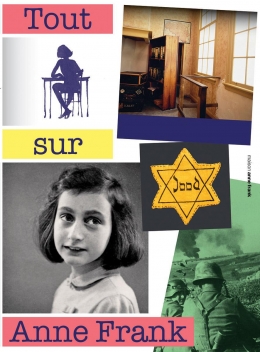
METSELAAR, Menno & Piet van Ledden
Tout sur Anne Frank
Translated by Mieke Sobering. Éditions Scholastic, 2018. 40p. Illus. GR. 5 up. 978-1-4431-6966-0. Hdbk. $24.99
Rating: E
“ Dans la nuit du 9 au 10 mai 1940, la famille Frank est réveillée par de fortes explosions… La guerre éclate!”
Tout sur Anne Frank created by la Maison Anne Frank is a biography about a little girl that is known to us as Anne Frank that survived the initial horrific Nazi regime in World War II.
The true biography of Anne Frank is introduced by a prologue “Joyeux anniversaire…” explaining her tenth birthday in Amsterdam with cheerful images of her with her circle of friends in 1939 accompanying the text. Her story begins in chronological order of when she was born in Germany in 1929. The biography goes on to explain in detail her family, where she lived, where she went to school, how she lived her day-to-day life and even the products that they may have consumed. Eventually by Chapter 3 “ La guerre!” and throughout, it illustrates her resilience and survival during the horrendous circumstances of the early stages of the war. However, unfortunately her beloved sister, her mother and Anne succumb to typhoid fever, leaving their father Otto Frank to live to an old age escaping the Holocaust.
Tout sur Anne Frank also delves into the historical aspect of when Hitler became the leader during her early life. Anne Frank and her family moved to The Netherlands, and Hitler took over and implemented laws against the Jews. Some of the inhumane laws were that Jews were not allowed to interact with the non-Jewish civilians of the country. They were not allowed to even attend movie theatres, parks and public spaces.
What is quite fascinating historically is that Jewish children as young as the age six had a yellow Star of David sewn onto their clothing to brand them, even if they were to simply take a walk on the street or to visit the local grocery store. And Jewish kids were only allowed to attend Jewish run schools, again taking away the opportunity from them and for the civilians of the Netherlands to interact with one another and find commonalities. Because of the restrictions of using public spaces Anne’s father Otto organized moving picture screenings in their own home inviting other Jewish friends for Anne’s thirteenth birthday.
Tout sur Anne Frank is a condensed take home museum in book form with full and half sheets, allowing the reader to flip back and forth to acquire snippets of information and images in multiple ways. The layout documents not only her life but supplies a wealth of visual imagery. The photo plates of consumer posters, maps, letters, actual photographs of Anne Frank, her family, her closest friends, and the life she lived and community around her are all organized methodically. There is even colour plates of drawings she had completed as school assignments. Even more intriguing are the detailed interior layouts of their residence highlighting the secret passageways and much more.
If you cannot make it to Anne Frank’s museum in Amsterdam, this is the closet thing you will get to experiencing and learning so much of her life and the heartfelt and painful moments of her day to day and life during war. Tout sur Anne Frank is exceptional.
Thematic Links: Anne Frank; World War II; Holocaust; Europe; Germany; Holland; Family; Friendship; Biography
Reviewed by Lara Chauvin in Vol. 24, #4
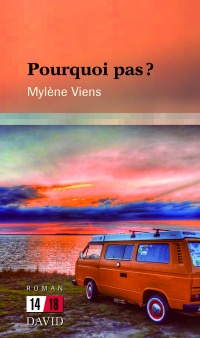
VIENS, Mylène
Pourquoi pas?
Les Éditions David, 2018. 296p. Gr. 7-12. 978-2-89597-659-2. Pbk. $14.95
Rating: E
Myriam has just finished secondary school and wants to get away and enjoy various things on her ‘bucket list’. The complication is that she has muscular dystrophy and has never before been away from home. She depends on her parents for many of her daily needs. However, the desire to really live life on her own terms is very strong and so, with the help of friends Elizabeth and Scott, Myriam travels to the area of Quebec City for a week and is able to test her limits and by doing so feel stronger and more in control of her own life.
Myriam is a main character who readers will remember long after this novel is finished. Despite her physical limitations, she is full of energy and enthusiasm and wants to live her life to the fullest. This includes trying new activities such as being on stage in front of a crowd, getting a tattoo and trying hang gliding for the first time. Her mantra becomes ‘Why not?’ and she is willing to challenge herself in order to follow her dreams.
This book provides insights into the world of a disabled person who is confined to a wheelchair and shows readers that they are no different than anyone else. Like able-bodied people they have hopes, dreams, emotions and needs. Myriam realizes that she cannot literally run away from her body and the illness she has suffered her entire life but by the end of the novel readers sense that she has become empowered and is ready to move on with her life and be successful.
Thank you, Mylène Viens, for a novel which is both thought provoking and humourous and which will increase our awareness and understanding of those around us.
Thematic Links: Muscular Dystrophy; Living Your Dream; Coming of Age
Reviewed by Ann Ketcheson in Vol. 24, #4